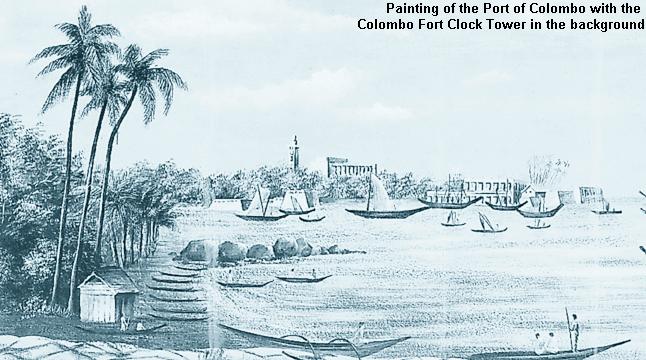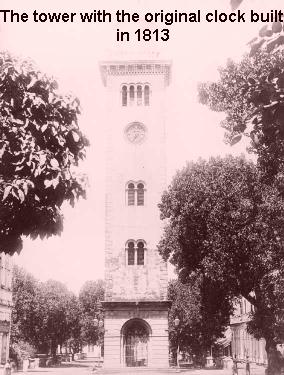





Colombo’s profile has changed much in the last decade or so with high-rise buildings dominating this emerging scenario. The City’s skyline which was once a quaint mixture of pre-modern architectural styles is now rapidly changing towards an international look. But does it then mean that older buildings in the City with a historical heritage should be neglected?
In many capital cities in the world, there are monumental structures that remind the city dwellers of their glorious past. For example the Eiffel Tower built by Gustave Eiffel in Paris in 1887, is considered an expression of French ingenuity and engineering skill and is a symbol of that historic city. So is the Leaning Tower of Pisa in Venice, Italy. The Italian govt. readily makes financial resources available to keep the Tower from falling.
Colombo is our capital and what do we have to remind us of our glorious past? Perhaps no one realises it- we have one such structure in the form of the Colombo Fort Clock Tower! It may not be as spectacular as the ‘Eiffel Tower’ or the’Leaning Tower of Pisa’ , but yet it is the only one of its kind in the world. It is a clock tower , bell tower and a lighthouse and believe me, this fact is recorded in the Guinness book too.

 The
tower with the orignal clock built in 1813 (Left), The original face of the
clock (Right)
The
tower with the orignal clock built in 1813 (Left), The original face of the
clock (Right)
The Colombo Fort Clock Tower stands at the junction of
Janadhipathi Mawatha and Chatham Street. The tower which is 96 feet tall was
built by Mr J. F. Churchill, a civil engineer and completed in February, 1857,
during the governorship of Sir Henry Ward who was appointed Governor of Ceylon
on May 11,1855. The clock tower was commissioned on March 25, 1857 two years
earlier than the ‘Big Ben’ in Westminister, England.
However, the clock, built by the same manufacturers as the ‘Big Ben’ clock, was made in 1813 and should have been commissioned 43 years earlier. But owing to its high cost of installation at the time, it was lying in the Commissariat Stores for almost half a century till Lady Ward discovered it and persuaded her husband to install it. Being an artist, she herself designed the Tower.
A century after the clock was built, it was replaced by a new clock in October, 1913 and the clock tower was re-inaugurated on April 4, 1914 and continued to chime the time. Whilst the Bell of the Big Ben weighed approx. 13 tons, the bells in the Colombo Fort Clock Tower consisted of a main Bell of approx. 5 Cwt. and two auxilliary Bells of 3 Cwt. each.
In 1867, ten years after the tower was built, a light was affixed on top of the tower to serve as a lighthouse due to the large number of ships calling over at Colombo Harbour. Prior to Colombo Harbour, Point-de-Galle was the chief port of call for mail, passenger and cargo ships. The early light in 1867 was lit by oil with an old fashioned dioptric apparatus revolved by clockwork. In 1907 the light was converted to gas. 1933 saw the introduction of electricity and a 1500 candle power electric light was installed which was visible for 18 miles.
Finally on July 12,1952 - after 90 long years - the light was permanently extinguished and was replaced by the present lighthouse at Galbokka point named as the New Colombo Lighthouse. This was due to the construction of tall buildings at Queen’s Street at the time that replaced the various military and civil officers. However the clock ticked on till 1996 till it was silenced by the Central Bank bomb.
A few months ago, I had the good fortune of climbing this tower in the company of Mr. David H. Shayt, a specialist in Clock Towers, Bell Towers and Lighthouses, of the Division of Cultural History of the Smithsonian Institution in Washington D. C.
Outwardly, the tower looked good. But inside - the steel rungs of the stairways had perished and some rungs were missing. We had to negotiate our climb to the top precariously. The bells were intact but the main bell had a crack on the crown probably due to the bomb blast. The faces of the clock and the clock mechanism were all damaged. A diamond pane in the lantern room was also damaged.
However, Mr. Shayt was of the view that the Colombo clock tower could be rehabilitated. How wonderful if this clock tower could tick and chime again and a token light be lit in the lantern room. Although now dwarfed by the imposing high-rise buildings, this Clock Tower, with every chime will remind the city dwellers of our glorious past especially considering that this area where the Clock Tower is situated is the principal financial and banking sector of Sri Lanka and hence the nerve centre of the country.
Continue to Plus page 8 - Appreciations
Return to the Plus contents page







Please send your comments and suggestions on this web site to
info@suntimes.is.lk or to
webmaster@infolabs.is.lk